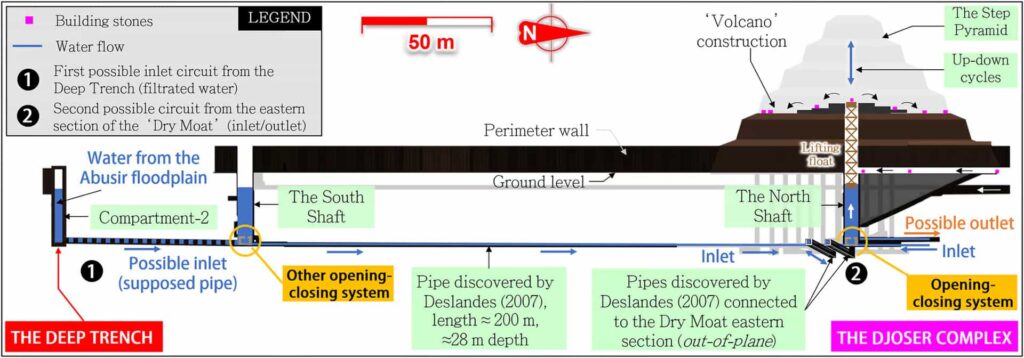The Step Pyramid of Djoser stands as the first monumental stone structure ever built in ancient Egypt, representing a significant leap in architectural design. Recent research has introduced a fascinating new hypothesis regarding its construction: the potential use of hydraulic lifts.
This groundbreaking theory challenges the traditional view that the ancient Egyptians relied solely on sheer manpower and basic tools. Instead, it suggests that they may have implemented advanced lifting mechanisms to assemble the towering structure, offering fresh insights into their engineering prowess and technical sophistication.
Egypt’s First Pyramid: A Marvel of Ancient Engineering
Pharaoh Djoser, a prominent figure of Egypt’s Third Dynasty, left an indelible mark on history with the creation of the country’s first pyramid. Situated at Saqqara, this grand tomb was more than just a resting place—it was a powerful symbol of divine authority and technical ingenuity.
Originally planned as a mastaba, the typical rectangular tomb of the time, the structure underwent a dramatic transformation under the guidance of Imhotep, Djoser’s visionary architect.
It evolved into a step pyramid, comprising six stacked terraces that reached skyward, representing the pharaoh’s journey to the realm of the gods. This architectural innovation not only demonstrated remarkable technical progress but also signaled a shift in the cultural and religious landscape of ancient Egypt.
The Step Pyramid set a precedent for subsequent pyramid constructions, reinforcing the profound connection between the pharaoh’s rule and the divine.
Hydraulic Lifts: The Ancient Egyptians’ Ingenious Tool
A recent discovery by French archaeologists and an international research team has upended our understanding of how the Pyramid of Djoser was constructed.
Evidence points to the existence of an intricate hydraulic system that may have served as an ancient elevator, capable of lifting massive stones and other heavy materials used in building the pyramid.
This system, cleverly woven into the pyramid’s architecture, likely utilized water stored in nearby reservoirs and dams to generate the hydraulic power necessary to elevate platforms loaded with construction materials.
By employing this advanced technique, the ancient Egyptians could have efficiently transported heavy stones to higher levels of the pyramid, reducing the need for labor-intensive methods and accelerating the construction process. This revelation suggests that their expertise in hydraulic engineering was far more sophisticated than previously thought.
Advanced Engineering in Ancient Egypt
The proposed use of hydraulic lifts in the construction of Djoser’s pyramid highlights the remarkable technical knowledge possessed by the ancient Egyptians. This system, which relied on water to elevate building materials, required a complex network of dams and canals designed to manage water resources effectively.
The construction of these dams, which controlled water flow and storage, reflects a deep understanding of fluid dynamics and water management. These technological advancements allowed the Egyptians to make the most of their resources, streamline labor efforts, and manage the intricate logistics of pyramid construction.
The ability to integrate such innovations with traditional building techniques showcases the Egyptians’ adaptability and ingenuity—qualities that have ensured the survival of their architectural marvels through the centuries.
The Endless Enigma: Unraveling the Construction of Egypt’s Pyramids
The recent uncovering of a hydraulic system believed to have been used in constructing Djoser’s pyramid challenges long-held views of ancient Egyptian engineering.
Traditionally, the building of these monumental structures has been attributed to sheer manpower and basic tools. However, this discovery sheds light on a far more advanced aspect of their technological prowess, revealing that the Egyptians were not only exceptional builders but also inventive engineers.
A groundbreaking study published in the journal PLOS ONE deepens our understanding of Egyptian ingenuity, offering surprising insights into their sophisticated use of hydraulics, a technology far ahead of what has been acknowledged by historical records.






